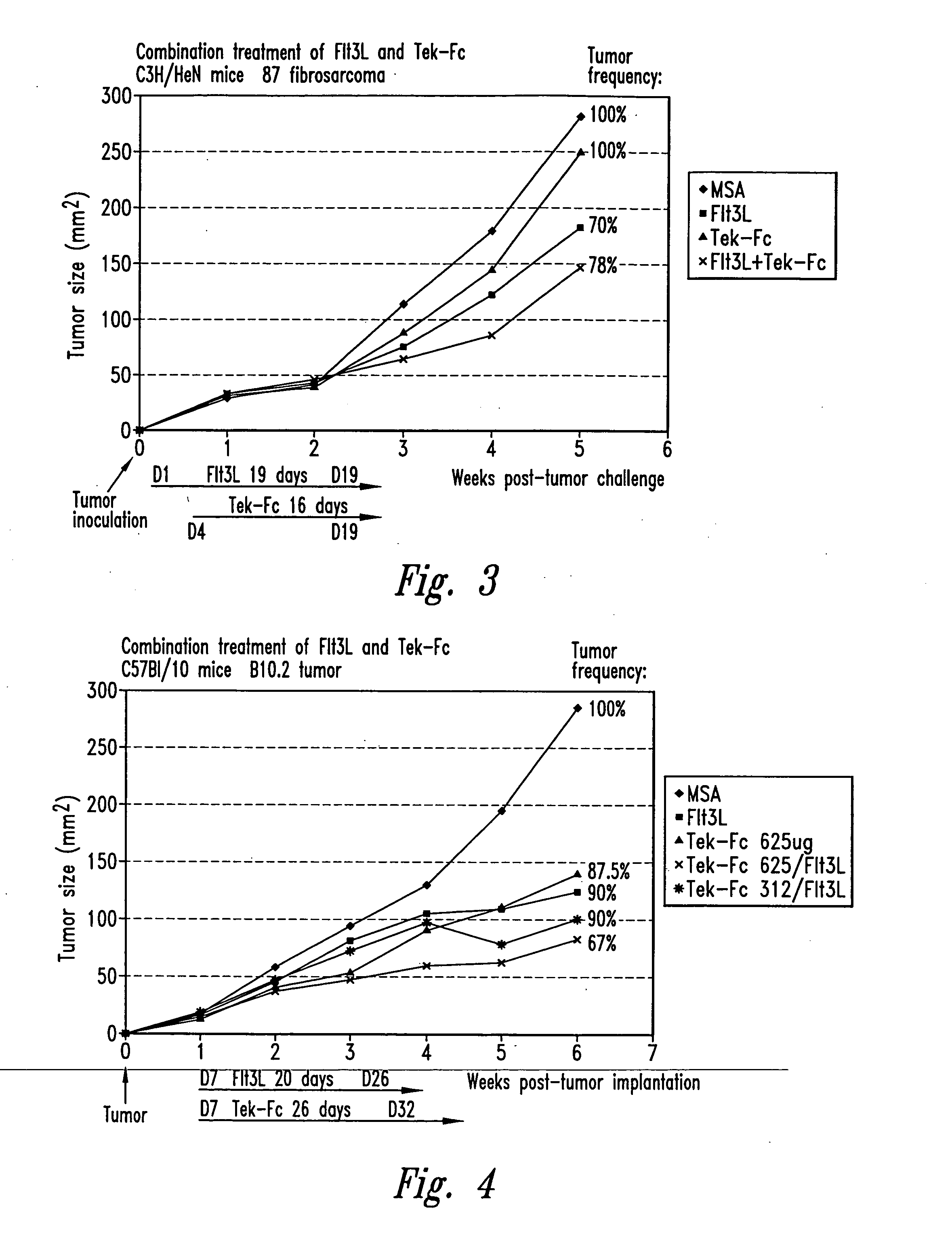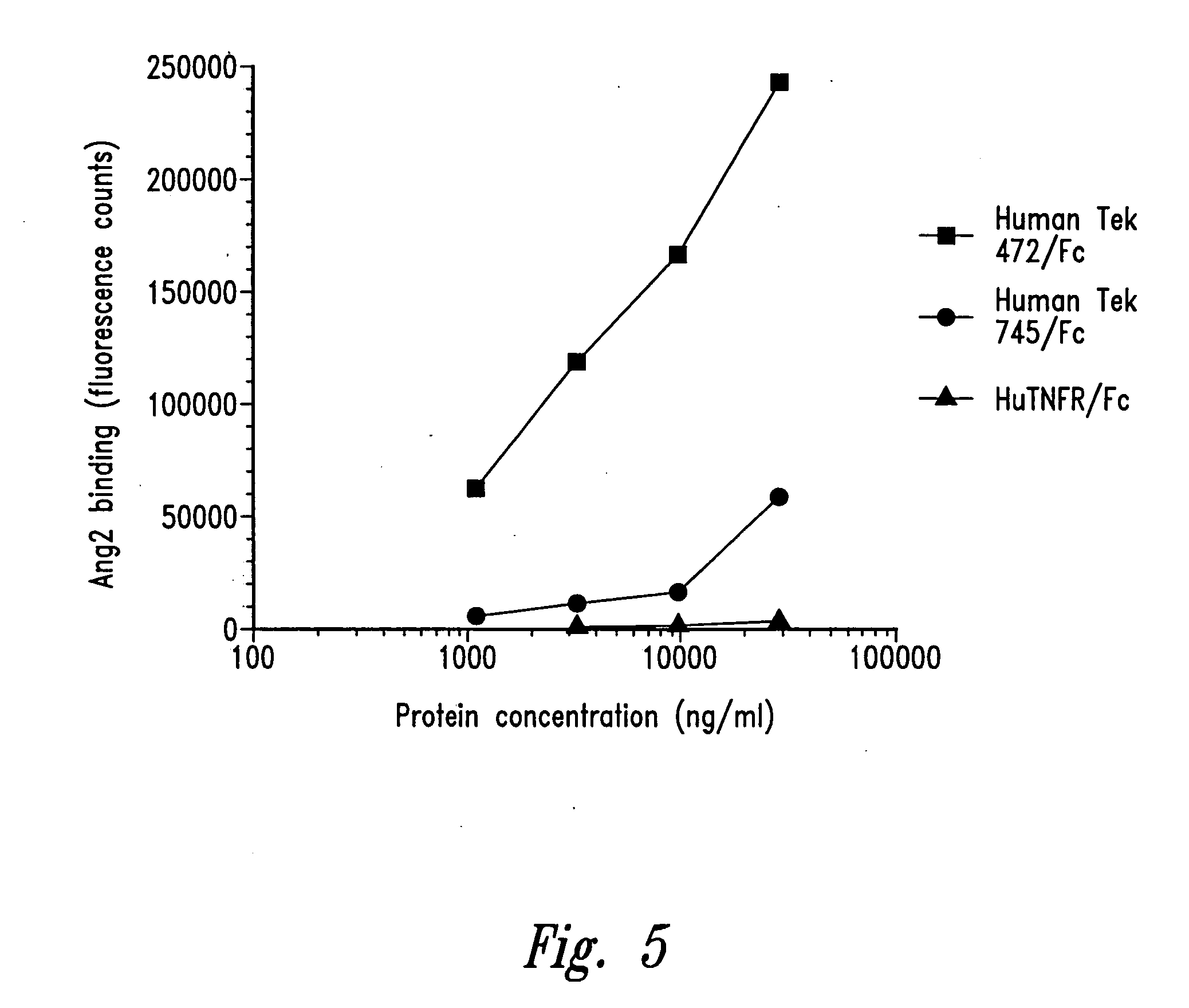Tek antagonists
a technology of antagonists and teks, applied in the field of tek antagonists, can solve problems such as pathological angiogenesis, and achieve the effect of preventing angiogenesis and achieving higher binding affinity
- Summary
- Abstract
- Description
- Claims
- Application Information
AI Technical Summary
Problems solved by technology
Method used
Image
Examples
example 1
Recombinant Production of Soluble Tek / Fc Fusion Polypeptides
[0116] The molecular cloning of a cDNA encoding the human receptor tyrosine kinase (RTK) Tek (ork, Tie2) is described in U.S. Pat. No. 5,447,860. The Tek cDNA (deposited with the American Type Culture Collection under the terms of the Budapest Treaty on 28 May 1992, Accession No. ATCC 69003) encodes 1124 amino acids, including a signal peptide, an N-terminal extracellular domain, a transmembrane domain, and a C-terminal cytoplasmic domain. Based on sequence analysis, the signal peptide is predicted to encompass residues 1-18, the N-terminal extracellular domain is predicted to encompass residues 19-745, the transmembrane domain is predicted to encompass residues 746-772, and the C-terminal cytoplasmic domain is predicted to encompass residues 773-1124. The extracellular domain includes two immunoglobulin (Ig)-like loops, a region containing three EGF-like cysteine repeats (between residues 211-340), and a region containing...
example 2
Activity of Tek / Fc in a Wound Closure Assay
[0121] A planar endothelial cell migration (wound closure) assay was used to quantitate the inhibition of angiogenesis by Tek / Fc in vitro. In this assay, endothelial cell migration is measured as the rate of closure of a circular wound in a cultured cell monolayer. The rate of wound closure is linear, and is dynamically regulated by agents that stimulate and inhibit angiogenesis in vivo.
[0122] Primary human renal microvascular endothelial cells, HRMEC, were isolated, cultured, and used at the third passage after thawing, as described in Martin et al., In Vitro Cell Dev Biol 33:261, 1997. Replicate circular lesions, “wounds,” (600-800 micron diameter) were generated in confluent HRMEC monolayers using a silicon-tipped drill press. At the time of wounding the medium (DMEM+1% BSA) was supplemented with 20 ng / ml PMA (phorbol-12-myristate-13-acetate), 10 μg / ml Tek472 / Fc, or combinations of 20 ng / ml PMA and 0.001-10 μg / ml Tek472 / Fc. The residua...
example 3
Activity of Tek / Fc in a Corneal Pocket Assay
[0123] A mouse corneal pocket assay was used to quantitate the inhibition of angiogenesis by Tek / Fc in vivo. In this assay, agents to be tested for angiogenic or anti-angiogenic activity are immobilized in a slow release form in a hydron pellet, which is implanted into micropockets created in the corneal epithelium of anesthetized mice. Vascularization is measured as the appearance, density, and extent of vessel ingrowth from the vascularized corneal limbus into the normally avascular cornea.
[0124] Hydron pellets, as described in Kenyon et al., Invest Opthamol. & Visual Science 37:1625, 1996, incorporated sucralfate with bFGF (90 ng / pellet), bFGF and IgG (11 μg / pellet, control), or bFGF and Tek472 / Fc (12.8 μg). The pellets were surgically implanted into corneal stromal micropockets created by micro-dissection 1 mm medial to the lateral corneal limbus of 6-8 week old male C57BL mice. After five days, at the peak of neovascular response to...
PUM
| Property | Measurement | Unit |
|---|---|---|
| temperature | aaaaa | aaaaa |
| pH | aaaaa | aaaaa |
| diameter | aaaaa | aaaaa |
Abstract
Description
Claims
Application Information
 Login to View More
Login to View More - R&D
- Intellectual Property
- Life Sciences
- Materials
- Tech Scout
- Unparalleled Data Quality
- Higher Quality Content
- 60% Fewer Hallucinations
Browse by: Latest US Patents, China's latest patents, Technical Efficacy Thesaurus, Application Domain, Technology Topic, Popular Technical Reports.
© 2025 PatSnap. All rights reserved.Legal|Privacy policy|Modern Slavery Act Transparency Statement|Sitemap|About US| Contact US: help@patsnap.com



